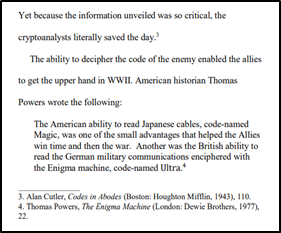The Chicago Manual of Style, 17th Edition presents a citation and format style, often referred to as Chicago, that is primarily used in professional publications and academic writing by those working in literature, history, the arts, and social sciences. Turabian style, outlined in A Manual for Writers of Research Papers, Theses, and Dissertations, is a simplified version of Chicago meant for undergraduate academic writing.
There are two primary Chicago and Turabian in-text citation styles: author-date and notes and bibliography. The difference between these two styles has to do with how they cite other sources. Author-date indicates the source of cited material using in-text parentheses and a corresponding reference list (like APA), while notes and bibliography uses a system of notes (footnotes or endnotes), which contains the citation information (author, title, date, etc.) in the notes, paired with a full bibliography at the end.
This handout provides a basic outline of the notes and bibliography citation style and format. Throughout the handout, Chicago and Turabian are cited (by the letters C and T, respectively), so readers can refer to the manuals for more information. While this handout covers general concepts, always work with your audience and assignment in mind.
Page numbers should be included and placed consistently, generally in one of four locations: (1) centered in the footer, (2) centered in the header, (3) flush right in the footer, or (4) flush right in the header.
For the body of the paper, use a standard font such as 12-point Times New Roman or 10-point Arial. In general, use a smaller size font (10- or 11-point) for notes.
Double-space the text and leave a one-inch margin on all sides of the document. Indent the first line of each paragraph. Single-space footnotes, endnotes, block quotes, and the bibliography.
Section headings or subheadings can be used to title different sections of your paper. Organizing your paper with titled sections helps the reader understand the structure of your argument, especially for longer papers. You can indicate higher or lower-level headings with boldface, italics, centering, and title caps, though Chicago is flexible on exactly what this looks like. Here’s a possible example:
| First Level: centered, bold or italics, title caps | The Problem of Universals in Medieval Philosophy |
|---|---|
| Second Level: centered, regular type, title caps | William of Ockham’s View of Universals |
| Third Level: left-aligned, regular type, title caps | Universals in Ockham’s Political Philosophy |
Longer quotations (for example, multi-paragraph quotations or quotations of more than 100 words) should be block-quoted. Block quotes are single-spaced and start on their own line with no quotation marks. The whole quote is indented from the left, generally by 0.5 inches (the same as a regular paragraph indent) with no extra first-line paragraph indent. There should be a blank line before and after the block quote. In notes and bibliography format, a footnote reference should follow the final punctation mark of the block quote.
Figures or illustrations can be placed in the body of the text to convey information in a more graphical manner or to reproduce an image for the reader’s convenience. Figures should be referenced in-text by the phrase Figure X (e.g. “Figure 3 shows that . . .”). Figures should be positioned close to their in-text reference. They should also be captioned, generally flush left beneath the image, with the word Figure and a number corresponding consecutively to the figures in the paper. This is followed by a short description of the figure (see Figure 1).
Information about paintings and images can generally be included in the text, but it can also appear in the reference list. They can be cited by the source (like a book or website) in which they were found (see C 3.30–37) or by the museum in which they are housed (see C 14.235).

Regardless of citation style, citing sources is a necessary and important part of academic writing because it allows writers to distinguish between their own ideas and the ideas of other authors. If writers do not acknowledge another author’s work, they commit plagiarism, which may have serious consequences.
The notes and bibliography system uses footnotes or endnotes to indicate the source of a particular quote, idea, or piece of information. These notes, which employ a superscripted number corresponding to an associated note at either the bottom of the page (footnote) or immediately preceding the bibliography (endnote), can be inserted into your text with an “insert footnote” or “insert endnote” button available in most word processors. The number typically appears after the final punctuation of the sentence in which material is referenced.

The note contains the citational information of the source, such as the author, title, publisher, etc., as well as optional commentary, such as further analysis or comparison with other sources. You may also cite multiple sources or multiple pages within the same source.
The citational information of the note is formatted differently than that same information contained in the bibliography page. In general, the note format substitutes periods for commas and uses the order of first name then last name. See below for examples.
After a source has already been cited in full, notes and bibliography permits note citation to be shortened, so that only necessary information like the author, title, and page number is present in the shortened note.

Sometimes sources are missing certain information, such as the name of the author or the publication date. With missing authors, leave the space blank and use the title of the piece in its place. With a missing publication date, use the acronym n.d. (no date) in place of the date. Otherwise, the general rule is to skip the piece of information if it is missing.
The notes and bibliography system uses a bibliography at the end of the paper where the information for the various sources used throughout the paper is contained. Format the bibliography as follows:

Since the notes-bibliography system conveys the citational information of a source both in the note and in the bibliography, there are two separate and distinct formats for writing a citation in notes and bibliography format. As noted above, the differences between these two formats are relatively minor. However, a list of citations in both formats is provided below.